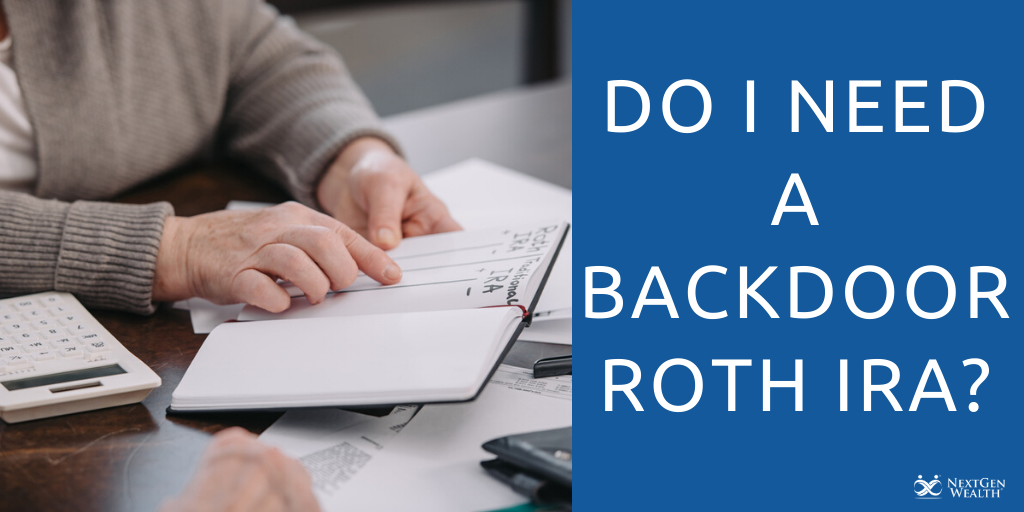Do I Need a Backdoor Roth IRA?
No matter how old you are, it’s never too late to start thinking about retirement. Although you will want to put money away in a variety of different accounts, one of the most reliable is an IRA. You may already be familiar with Traditional and Roth IRAs, but the fact is there is a way to move money from a Traditional to a Roth, which is considered a Backdoor Roth IRA or a Roth Conversion.
Both actually do the same thing in a slightly different way. A Backdoor Roth IRA is typically in relation to converting a Traditional non-deductible contribution to a Roth IRA. A Roth Conversion is normally in relation to a larger amount being converted from a Traditional to a Roth. Again, they both do the same thing but just have different names. Today, we’re going to focus on the Backdoor Roth IRA.
This process can potentially help with taxes, amongst other things, so pay close attention to how it works and if it makes sense for your situation. With that in mind, let's take a deep dive into the world of Backdoor Roth IRAs and how they can potentially benefit your retirement savings.
Comparing IRAs: Roth vs. Traditional
To understand how a Backdoor Roth IRA works, we need to look at the inner workings of both IRA options. Here is a brief breakdown of how they work.
Hoping to retire in the next 5 years or less? Download our 3 Pillars of Successful Retirement Plans.
Roth IRA
With this kind of account, you make contributions that aren’t tax-deductible. But, you also don’t have to pay taxes when you make a qualified withdrawal. Tax-free withdrawals are one of the biggest advantages of a Roth IRA.
To contribute to a Roth IRA, you have to fall within the income limits below.
2020 Roth IRA Income Limits
|
Filing Status |
Roth IRA |
|
Married, Filing Jointly |
Phase out starting at $196,000 - $206,000 |
|
Married, Filing Separately |
Phase out starting at $0 - $10,000 |
|
Single |
Phase out starting at $124,000 - $139,000 |
|
Head of Household |
Phase out starting at $124,000 - $139,000 |
Even if you do qualify to contribute to a Roth IRA, there are limits to how much you can contribute. In 2020, the maximum amount is $6,000, or $7,000 if you’re 50 or older.
Another crucial tax advantage of a Roth IRA is that there are no distribution requirements. The money can sit in the account, tax-free, for as long as you like. This makes Roth IRAs an ideal wealth management tool as the funds can be passed onto future generations without paying taxes.
That being said, if a Roth does pass to a beneficiary, he or she will either be subject to forced withdrawals, or the individual will need to move the funds to a personal Roth IRA instead. Fortunately, though, beneficiaries still don’t need to pay taxes on withdrawals.
Finally, with regards to withdrawal limitations, Roth IRAs have no restrictions, age or otherwise. If you need or want to take money out of the account, you can do so at any time. However, because the account can appreciate, you may have to pay taxes and/or a 10% penalty for any earnings that you withdrawal (funds that you didn’t contribute directly).
To avoid these costs, you have to fulfill at least one of the following requirements:
- Be 59.5 years old or older
- Be permanently disabled
- Be a beneficiary of a Roth IRA (i.e., the original account owner died)
- Use the money for a first-time home purchase
Not only do one of these conditions have to apply, but you also need to have held the account for at least five years. If your Roth IRA is younger than that, you will need to pay taxes on the earnings. However, the 10% penalty fee won’t apply if you still meet one of the requirements listed above.
Traditional IRA
This kind of account has vastly different rules regarding all of the various conditions we outlined in a Roth IRA. When it comes to contributions, you get to deduct them from your taxes in a given year.
The primary benefit here is that you could potentially qualify for certain tax benefits (besides just lowering your income) since your adjusted gross income (AGI) can be lowered. For example, if you want to claim a child tax credit but make too much money, you could contribute to a traditional IRA and then might qualify.
On the flip side, you will have to pay taxes when you withdraw the money. Fortunately, your tax rate will be based on your income at the time, so if you are retired, you might be in a lower tax bracket since you’re not earning money from a job.
To contribute to a Traditional IRA and get the tax-deduction, you have to fall within the income limits below.
2020 Traditional IRA Income Limits
|
Filing Status |
Traditional IRA |
|
Married, Filing Jointly, With Workplace Plan |
Phase out starting at $104,000 - $124,000 |
|
Married, Filing Jointly, Without Workplace Plan |
Phase out starting at $196,000 - $206,000 |
|
Married, Filing Separately |
Phase out starting at $0 - $10,000 |
|
Single |
Phase out starting at $122,000 - $137,000 |
|
Single, Covered By Workplace Retirement Plan |
Phase out starting at $65,000 - $75,000 |
Just like a Roth IRA, you can still only contribute $6,000, or $7,000 if you’re over 50 in 2020. Once you turn 70 1/2, though, you can no longer put money into your Traditional IRA. Instead, you will be forced to take money out.
Required minimum distributions (RMDs) are an integral part of Traditional IRAs. Once you reach the qualifying age (70.5), you have to withdraw money from the account. The amount will depend on a variety of factors, and the IRS has a calculator to help you determine what that amount will be. If you want to take more money out, though, that is allowed.
As far as age requirements, you can’t take funds from a Traditional IRA penalty free until you reach 59 1/2. If you’re younger than that, you’ll incur a 10% penalty. However, disability or undue hardship can typically waive this fee, as can using the money for a first-time down payment.
What is a Backdoor Roth IRA?
Now that we understand how both types of IRA accounts work, it’s much easier to dive into a Backdoor Roth IRA. This term refers to a method of converting a Traditional IRA contribution to a Roth IRA - it’s not actually a unique account type.
Basically, the way it works is like this:
- Your income is over the Roth IRA income limits (see above) to contribute
- So, you need to open a Traditional IRA and make what’s called a non-deductible contribution. The key here is a non-tax-deductible contribution.
- You will then convert this Traditional IRA (or at least the amount of the contribution you just made) to a Roth IRA (open one if needed). This process is relatively straightforward, although there is paperwork involved. I would suggest speaking with a professional before implementing this strategy to ensure it makes sense for your situation as there can be tax consequences if you hold additional monies in other Traditional IRA’s..
As far as how the tax consequences work if you do have a Traditional IRA with additional funds above and beyond the contribution just made, the IRS uses what’s called the Pro-Rata Rule. This rule is relatively complex, but essentially, the IRS looks at the funds within your traditional IRA account and determines your tax rate based on the ratio of contributed money to earned income. For example, if 80 percent of the IRA is contributions (funds you put into the account) and 20% is accrued earnings, your rate will reflect that.
Also, keep in mind that this rule applies to the total IRA balance at the end of the year, not the conditions at the time of conversion. In some cases, this aspect can influence how much you pay in taxes. Again, we highly suggest speaking with a financial advisor or tax professional before implementing this strategy.
Why Use a Backdoor Roth IRA?
To the uninitiated, using a backdoor Roth IRA may seem counterintuitive at first. If you can simply contribute funds to the account directly, why go through the extra steps of converting a Traditional IRA? Well, the reality is that there are a few reasons for utilizing this method, so let’s break them down.
First of all, as we mentioned above, income limitations can prevent you from contributing money to a Roth at all. If your income is over $139,000 (single) or $206,000 (joint) in 2020, then a backdoor conversion will be the only option you have for getting money into a Roth IRA.
Getting a Backdoor Roth IRA may also be a good option if you expect to be in a higher tax bracket later on. As you’ll recall, the taxes you pay on a Traditional IRA withdrawal are based on your current income. So, if you’re making more money in the future, you could be hit with a higher tax bill.
Backdoor Roth IRAs can be beneficial if you expect that you’ll need to withdraw funds from a Traditional IRA before turning 59 1/2. That being said, money that was converted to a Roth does have to sit in the account for five years.
The reason for this is that the money you put in from the conversion doesn’t count as a regular contribution. Instead, it counts as earned income. As you’ll recall, any earnings from a Roth will incur taxes and a 10% penalty if the account is less than five years old. In this case, a backdoor conversion triggers this rule.
Another major benefit to the Roth IRA is that there are no required minimum distributions (RMD) at age 70.5 as their are with a Traditional IRA. These RMD’s force you to pay taxes on this money regardless of whether you need it or not. Moving it into a Roth IRA allows you the freedom to withdraw the money when you want on a tax-free basis without any RMD’s.
Other Considerations Regarding Backdoor Roth IRAs
While there are some significant advantages to using a Backdoor Roth IRA, you need to make sure that it’s the right move. Here are some factors that you want to consider beforehand and discuss with your financial advisor.
- Paying Taxes - be sure to calculate how much you will owe from the conversion. The worst thing to do is use IRA funds to pay your tax bill, as you could incur the 10% penalty and reduce tax-deferred growth in the IRA.
- Higher Tax Bracket - the funds you withdraw from your IRA could push you into a higher tax bracket, so be sure that you won’t trigger this condition. Be sure to talk to your advisor to see if this will occur.
- Early Withdrawals - if you think that you need the money before the five-year rule expires, you could wind up taking a substantial hit. If you do need funds faster, it’s probably better to find an alternative method of getting them.
Work with a Financial Advisor or Tax Professional
As you can see, doing a Backdoor Roth IRA is relatively straightforward, but there are some considerations to make before going through with it. You never want to move money around without understanding the details and/or the possible consequences. Be sure to talk to your financial advisor today about the potential advantages and disadvantages of this move.



